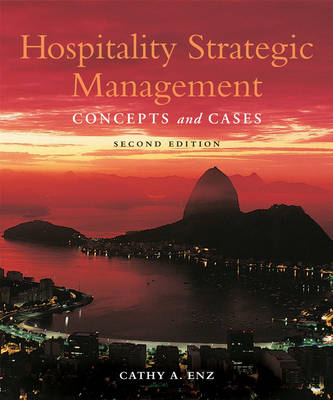
Hospitality Strategic Management
John Wiley & Sons Ltd (Verlag)
978-0-470-08359-8 (ISBN)
- Titel ist leider vergriffen;
keine Neuauflage - Artikel merken
Cathy A. Enz is the Lewis G. Schaeneman Jr. Professor of Innovation & Dynamic Management at the School of Hotel Administration at Cornell University, where she is also the Executive Director of the Center for Hospitality Research. Winner of outstanding teacher and researcher awards, she teaches courses in strategic management and innovation.
Preface. About The Author. Chapter 1: Strategic Management. Introduction. The Origin of Strategic Management. The Traditional Perspective. The Organization as a Bundle of Resources: The Resource-Based View. The Organization as a Network of Stakeholders. The Strategic Management Process. Situation Analysis. Strategic Direction. Strategy Formulation. Strategy Implementation. Global Competitiveness in the Hospitality Industry. Variables Affecting Strategic Management. Strategic Thinking. Strategic Planning Can Drive out Strategic Thinking. Characteristics of Strategic Thinking. Motivating Managers and Employees to Think Strategically. Strategic Management in the Hospitality Industry. The Foodservice Industry--The Players. The Lodging Industry--The Players. Key Points Summary. Review Questions. Critical Thinking & Application Questions. Notes. Chapter 2: The Environment and External Stakeholders. Introduction. Assessment of the Broad Environment. The Sociocultural Context. The Economic Context. The Political Context. The Technological Context. Change and Interdependence among the Broad Environmental Forces. Gathering Information on International Environments. Analysis of External Stakeholders and the Operating Environment. Porter's Five Forces, Economic Power, and Industry Characteristics. External Stakeholders, Formal Power, and Political Influence. Managing the Operating Environment. Economic Actions. Political Strategies. Partnering with External Stakeholders. Key Points Summary. Review Questions. Critical Thinking & Application Questions. Notes. Chapter 3: Strategic Direction. Introduction. Creating a Strategic Direction. Key Influences on Direction. Mission Statements. Organizational Vision. Organizational Values. Social Responsibility. Enterprise Strategy. Ethical Frames of Reference. Codes of Ethics. Ethics in Global Environments. Key Points Summary. Review Questions. Critical Thinking & Application Questions. Notes. Chapter 4: Organizational Resources and Competitive Advantage. Introduction. Internal Analysis and Competitive Advantage. Sustainable Competitive Advantage. Value-Adding Activities. The Value Chains of Wine Makers. Value-Chain Activities. The Tourism Value Chain. Tangible and Intangible Resources. Resources and Capabilities. Financial Resources. Financial Ratios. Physical Resources. Architectural and Sustainable Design. Human-Based Resources. Strategic Leadership. Ownership and Management. Employees. Structure and Culture. Knowledge-Based Resources. Internal Knowledge Creation and Organizational Learning. Knowledge Creation. Knowledge Creation and Interorganizational Relationships. General Organizational Resources. Patents, Copyrights, Trademarks, and Servicemarks. Brands and Organizational Reputation. Superior Relationships with Stakeholders. Key Points Summary. Review Questions. Critical Thinking & Application Questions. Notes. Chapter 5: Strategy Formulation at the Business Unit Level. Introduction. Generic Business Strategies. Cost Leadership. Differentiation. Best Value. Focus. Competitive Dynamics. Strategies that Reflect Competitive Dynamics. Resources, Industry Structure, and Firm Actions. Strategic Group Mapping. Developing a Strategic Group Map. Key Points Summary. Review Questions. Critical Thinking & Application Questions. Notes. Chapter 6: Corporate Level Strategy and Restructuring. Introduction. Concentration Strategies. Advantages and Disadvantages of a Concentration Strategy. Vertical Integration Strategies. Advantages and Disadvantages of a Vertical Integration Strategy. Vertical Integration and Transaction Costs. Substitutes for Full Vertical Integration. Diversification Strategies. Related Diversification. The Creation of Synergy. Unrelated Diversification. Mergers and Acquisitions. Consolidation. Merger Performance. Successful And Unsuccessful Mergers And Acquisitions. Strategic Restructuring. Turnaround Strategies and Downsizing. Refocusing Corporate Assets. Chapter 11 Reorganization. Leveraged Buyouts. Changes to Organizational Design. Portfolio Management. The Boston Consulting Group (BCG) Matrix. Destination Portfolio Analysis. Key Points Summary. Review Questions. Critical Thinking & Application Questions. Notes. Chapter 7: Strategy Implementation Through Interorganizational Relationships and Management of Functional Resources. Introduction. Interorganizational Relationships and the Tourism Cluster. Advantages and Disadvantages of Interorganizational Relationships. Stakeholder Management and the Selection of Partners. Buffering vs. Partnering. Effective Stakeholder Management. Managing Partnerships. Functional Level Resource Management. Marketing Strategy. Human Resources Strategy. Operations Strategy. Key Points Summary. Review Questions. Critical Thinking & Application Questions. Notes. Chapter 8: Strategy Implementation Through Organizational Design and Control. Introduction. Organizational Structures. Simple Management Structures. Business Level vs. Corporate Level Structures. Types of Business Level Structures. Corporate Level Structures. The Lateral Organization. Simple Coordinating Mechanisms. Formal Integrators. Organizational Control. Strategic vs. Financial Controls. Feedback-Control Systems. Feedforward Control. Other Types of Controls. Crisis Prevention and Management. Key Points Summary. Review Questions. Critical Thinking & Application Questions. Notes. Chapter 9: Strategies for Entrepreneurship and Innovation. Introduction. Entrepreneurial Start-ups. The Entrepreneur. Entrepreneurial Tasks. Franchising. Causes of Failure. Innovation and Corporate Entrepreneurship. Fostering Innovation in Established Firms. The Internet and E-Commerce. Key Points Summary. Review Questions. Critical Thinking & Application Questions. Notes. Chapter 10: Global Strategic Management and the Future. Introduction. Global Strategies. Multidomestic, Global, and Transnational Strategies. Market Entry Tactics. International Alliances and Business Format Franchising. International Market Selection. Institutional Differences. National Advantages. Global Stakeholders. Stakeholder Management in Foreign Environments. Strategic Management in Hospitality Firms in the Future. Key Points Summary. Review Questions. Critical Thinking & Application Questions. Notes. Cases. Case Study Matrix. Case Note: Learning Through Case Analysis. Case 1: The Fun Ship Experience at Carnival Cruise Lines. Case 2: Building Capabilities at The Westward Hilton. Case 3: Intercontinental Hotel Group's Entry Into China. Case 4: The Summer of 2006 Union Negotiations: Unite Here's Strategy. Case 5: Banyan Tree: Sustainablility of a Brand During Rapid Global Expansion. Case 6: Starwood Hotels and Resorts Brings Aloft to India . Case 7: The Commoditization of Starbucks . Case 8 The Movement of Travel Services Online: Intermediaries and Branded Distribution. Glossary. Index.
| Verlagsort | Chichester |
|---|---|
| Sprache | englisch |
| Maße | 198 x 234 mm |
| Gewicht | 1332 g |
| Themenwelt | Weitere Fachgebiete ► Handwerk |
| ISBN-10 | 0-470-08359-X / 047008359X |
| ISBN-13 | 978-0-470-08359-8 / 9780470083598 |
| Zustand | Neuware |
| Haben Sie eine Frage zum Produkt? |
aus dem Bereich


